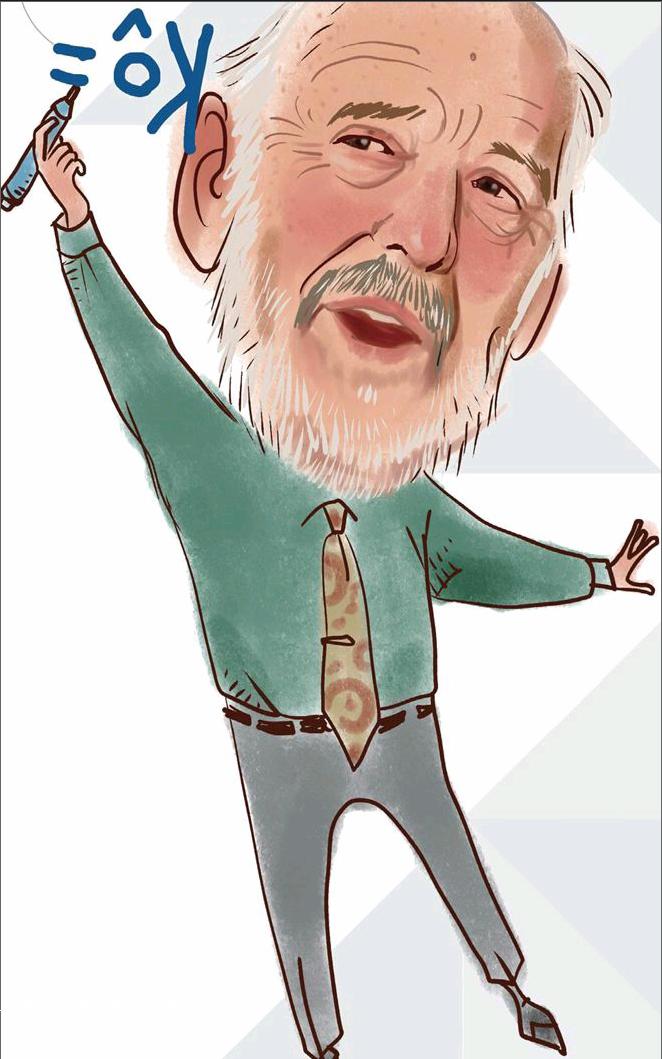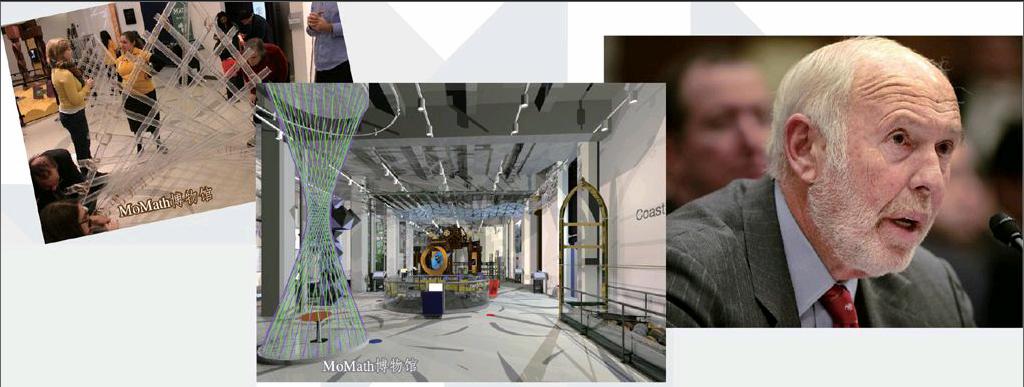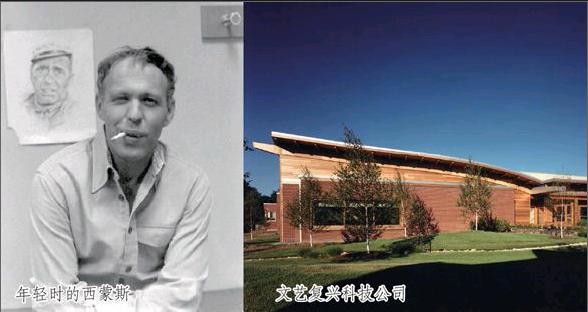詹姆斯·H·西蒙斯:非典型数学家的无限可能
文/William+J.+Broad+译/祝莉丽



James H. Simons likes to play against type. He is a billionaire star of mathematics and private investment who often wins praise for his financial gifts to scientific research and programs to get children hooked on math.
But in his Manhattan office, high atop a Fifth Avenue building in the Flatiron district, hes quick to tell of his career failings.
He was forgetful. He was demoted. He found out the hard way2) that he was terrible at programming computers. “Id keep forgetting the notation,” Dr. Simons said. “I couldnt write programs to save my life3).”
After that, he was fired.
His message is clearly aimed at young people: If I can do it, so can you.
Down one floor from his office complex is Math for America, a foundation he set up to promote math teaching in public schools. Nearby, on Madison Square Park, is the National Museum of Mathematics, or MoMath, an educational center he helped finance. It opened in 2012 and has had a quarter million visitors.
Dr. Simons received his doctorate at 23; advanced code breaking for the National Security Agency at 26; led a university math department at 30; won geometrys top prize at 37; founded Renaissance Technologies, one of the worlds most successful hedge funds4), at 44; and began setting up charitable foundations at 56. This year, he was elected to the National Academy of Sciences, an elite body that Congress founded during Lincolns presidency to advise the federal government.
With a fortune estimated at $12.5 billion, Dr. Simons now runs a tidy5) universe of science endeavors, financing not only math teachers but hundreds of the worlds best investigators. His favorite topics include gene puzzles, the origins of life, the roots of autism6), math and computer frontiers, basic physics and the structure of the early cosmos.
Working closely with his wife, Marilyn, Dr. Simons has pumped more than $1 billion into esoteric7) projects as well as retail offerings like the World Science Festival and a scientific lecture series at his Fifth Avenue building.
On a wall in Dr. Simonss office is one of his prides: a framed picture of equations known as Chern-Simons, after a paper he wrote with Shiing-Shen Chern, a prominent geometer. Four decades later, the equations define many esoteric aspects of modern physics, including advanced theories of how invisible fields like those of gravity interact with matter to produce everything from superstrings8) to black holes.
A Boyhood Love of Math and Logic
Dr. Simons said he knew as a boy that he loved math and logic. At 14, during a Christmas break, he was hired by a garden supply store for a stockroom job. But he was quickly demoted to floor sweeper after repeatedly forgetting where things went. His bosses were incredulous9) when, at vacations end, he told them he wanted to study mathematics at the nearby Massachusetts Institute of Technology.
Excellent test scores and the recommendation of a high school adviser got him into the prestigious school. He graduated in three years, and received his doctorate from the University of California, Berkeley, in three more. It was at Berkeley that he met Dr. Chern, a math prodigy10) from China. In his doctoral thesis, Dr. Simons advanced the mathematical understanding of curved spaces, a topic Einstein exploited in his general theory of relativity to show how gravity deforms space and time.
Returning east, he taught math at M.I.T., then Harvard. In 1964, he was recruited into the shadowy world of government spying. At Princeton, while ostensibly11) part of the academic elite, he worked for the Institute for Defense Analyses.
At Princeton, Dr. Simonss cryptography strides12) helped the N.S.A. break codes and track potential military threats. But he failed as a programmer.
He also managed to fall into political conflict with his boss, Maxwell D. Taylor, a retired four-star Army general. In 1967, General Taylor defended the Vietnam War in a New York Times Magazine article. Dr. Simons objected. His reply, also published in The Times, said the conflict would “diminish our security” and urged a pullout “with the greatest possible dispatch13).”
Soon after, he was dismissed, and Stony Brook University on Long Island courted14) him to become its math chairman. “It was a lousy department,” he recalled. “When I was interviewed by the provost15), he said, ‘Well, Dr. Simons, I have to say youre the first person weve interviewed for this job who actually wants it.”
“I said: ‘I want it. I want it. It sounds like fun. And it was fun. And I went there, and we built up a very good department.”
In 1976, Dr. Simons won the Oswald Veblen Prize16) of the American Mathematical Society—geometrys highest honor—raising the departments stature.
But he became restless, and the business world beckoned17). In 1978, he founded a predecessor to Renaissance Technologies in a strip mall18) close to the Stony Brook campus. In 1982, he set up Renaissance, which grew to occupy a 50-acre campus, complete with tennis courts.
In time19), his novel approach helped change how the investment world looks at financial markets. The man who “couldnt write programs” hired a lot of programmers, as well as physicists, cryptographers, computational linguists, and, oh yes, mathematicians. Wall Street experience was frowned on. A flair for science was prized. The techies gathered financial data and used complex formulas to make predictions and trade in global markets.
The company thrived, rewarding investors with double-digit annual returns. It marked an early triumph of the “quants20)”—quantitative analysts who use advanced math to guide investments—and foreshadowed the ascendency of Big Data.
He also conceded that his curiosity drove him to examine all kinds of unusual possibilities, such as whether sunspots and lunar phases influenced the financial markets.
Success and Tragedy Were Companions
His philanthropic work began in 1994 when he and his wife founded the Simons Foundation, followed by other charities. Tragedy hit as his successes grew. On Long Island in 1996, his son Paul, 34, was killed by a car while riding a bicycle. In 2003, a younger son, Nicholas, 24, drowned while globetrotting21).
Dr. Simons said he began thinking a lot about old math riddles. “It was a refuge,” he said, “a quiet place in my head.” One morning in Katmandu, as he relaxed on a hotel porch, the structure of a proof suddenly came to him. It was a solid advance—one he didnt forget. He discussed it with Dennis P. Sullivan, a mathematician at Stony Brook, and the two collaborated. In 2007, the resulting paper ran under the title “Axiomatic22) Characterization of Ordinary Differential Cohomology23).” Dr. Sullivan said that Dr. Simons, in his career, had made a series of seminal contributions and that an early one “revolutionized the consciousness of later generations.”
In 2010, he and his wife were among the first billionaires to sign the Giving Pledge24), promising to devote “the great majority” of their wealth to philanthropy. Of late, Dr. Simons said, his giving had accelerated, adding that he was particularly proud of Math for America. It awards stipends25) and scholarships of up to $100,000 to train high school math and science teachers and to supplement their regular salaries.
His passion, however, is basic research—the risky, freewheeling type. He recently financed new telescopes in the Chilean Andes that will look for faint ripples of light from the Big Bang, the theorized birth of the universe.
The afternoon of the interview, he planned to speak to Stanford physicists eager to detect the axion26), a ghostly particle thought to permeate the cosmos but long stuck in theoretical limbo27). Their endeavor “could be very exciting,” he said, his mood palpable28), like that of a kid in a candy store.
For all his self-deprecations, Dr. Simons does credit himself with a contemplative quality that seems to lie behind many of his accomplishments.
“I wasnt the fastest guy in the world,” Dr. Simons said of his youthful math enthusiasms. “I wouldnt have done well in an Olympiad or a math contest. But I like to ponder. And pondering things, just sort of thinking about it and thinking about it, turns out to be a pretty good approach.”
詹姆斯·H·西蒙斯喜欢打破常规。他是一位拥有亿万家产的数学精英和私人投资精英,经常因资助科学研究和让儿童对数学感兴趣的项目而获得赞誉。
但是在他位于曼哈顿的办公室里——办公室位于熨斗区第五大道的一座大厦高层——他很快便谈到了自己职业生涯的低潮。
他曾经很健忘。他曾被降过职。他在吃过苦头之后才发现自己在电脑编程方面糟糕得一塌糊涂。“我总是忘记那些符号,”西蒙斯博士说,“我死活都不会写程序。”
在那之后,他被解雇了。
他显然是在向年轻人传达这样的信息:如果我都能成功,你也能。
位于他办公区下面一层的是“数学为美国”——由他创建的一个基金会,旨在提升公立学校的数学教学水平。不远处,在麦迪逊广场公园里,有一个国家数学博物馆,也被称为MoMath,那是他出资协建的一个教育中心。博物馆于2012年开放,迄今已经接待了25万参观者。
西蒙斯博士23岁获得博士学位;26岁推进了国家安全局的密码破译工作;30岁任大学数学系主任;37岁夺得几何学的最高奖项;44岁创建文艺复兴科技公司——世界上最成功的对冲基金管理机构之一;56岁开始筹办慈善基金会。今年,他入选国家科学院,这是国会在林肯任总统期间创建的精英团体,旨在为联邦政府献计献策。
身价预计达到125亿美元的西蒙斯博士目前管理着数量颇为可观的科学项目,他不仅为数学教师提供资金支持,还资助世界各地成百上千的优秀研究者。他最喜欢的课题包括基因之谜、生命起源、孤独症的根源、数学和计算机领域的前沿、基础物理以及早期宇宙结构。
在与妻子玛丽莲的紧密合作下,西蒙斯博士已在深奥的项目上投入逾10亿美元,同时也零零散散地捐助一些活动,比如世界科学节以及在他所在的第五大道的办公楼里开办的系列科学讲座。
西蒙斯博士办公室的墙上挂着令他骄傲的成就之一:镶在相框里的人称“陈-西蒙斯”的方程式,它们出自西蒙斯与杰出几何学家陈省身共同撰写的论文。40年过去了,这些方程式为现代物理学中许多深奥的问题提供了解释,包括诸如重力场这类无形的场如何与物质相互作用,从而产生超弦、黑洞等现象的先进理论。
热爱数学和逻辑的少年时代
西蒙斯博士说孩提时代他就知道自己热爱数学和逻辑。14岁那年的圣诞假期,他受雇于一家园艺用品店,从事库房管理工作,但很快就被降为地板保洁员,因为他一再忘记货物存放的位置。当假期结束,西蒙斯对上司说自己想去附近的麻省理工学院学数学时,他们简直难以置信。
西蒙斯凭借优异的考试成绩和高中导师的推荐得以进入那所名校。三年后他顺利毕业。之后他又用三年时间取得了加州大学伯克利分校的博士学位。正是在伯克利分校时,他遇到了陈博士,一位来自中国的数学奇才。在博士论文中,西蒙斯博士推进了对弯曲时空的数学解释,那是爱因斯坦在他的广义相对论中用来展示重力是如何让空间和时间发生变形的课题。
回到东部以后,他曾在麻省理工学院教数学,后来又去了哈佛任教。1964年,他被神秘的政府间谍部门招入麾下。在普林斯顿,他表面上是一个学术精英,实际上是在为国防分析研究所效力。
在普林斯顿,西蒙斯博士在密码学技术方面取得的进展对美国安全局破解代码和跟踪潜在的军事威胁很有帮助。但他却是一个失败的程序员。
他还和他的上司——退役的四星陆军上将麦斯威尔·D·泰勒发生了政治冲突。1967年,泰勒上将在《纽约时报杂志》上发表了一篇为越南战争辩护的文章。西蒙斯博士对此表示反对。他的回应也发表在《纽约时报杂志》上,他说冲突会“削弱我们的安全”,竭力主张“以尽可能快的速度”撤军。
这之后不久,他就被解雇了,位于长岛的纽约州立大学石溪分校邀请他担任该校的数学系主任。“那个系很糟糕,”他回忆道,“教务长面试我的时候说:‘西蒙斯博士,我必须告诉你,在我们面试过的应聘这个职位的人中,你是第一个真正想要这份工作的人。”
“我说道:‘我想做这份工作,我愿意做,它听起来挺有意思。而且确实有意思。我去了那儿,我们把那个系建设得很好。”
1976年,西蒙斯博士获得了美国数学学会颁发的韦伯伦几何学奖——几何学的最高荣誉,这使他所在系的地位得以提升。
但是他开始不满足于此,商界向他发出了召唤。1978年,他在石溪分校旁边沿公路的商业区创建了文艺复兴科技公司的前身。1982年,他成立了文艺复兴科技公司,其后来逐渐发展成占地50英亩并附带网球场的公司。
最终,他的创新方法改变了投资界对金融市场的看法。这个“不会编程”的人雇了很多程序员,还有物理学家、密码学家、计算机语言专家,哦,当然,还有数学家。在这里,华尔街的经验不受青睐。科学才华受到珍视。工程师们收集金融数据,然后使用复杂的公式进行预测,并在全球市场进行交易。
公司蓬勃发展,每年为投资者带来两位数的回报。这标志着“宽客”——利用高等数学知识指导投资的量化分析师——取得了初步成功,也预示着大数据将占据支配地位。
西蒙斯也承认,他的好奇心促使他去探索各种非同寻常的可能性,比如太阳黑子和月相是否对金融市场有影响。
成功与灾难如影随形
他的慈善事业始于1994年,那年他和妻子成立了西蒙斯基金会,此后又陆续建立了其他慈善机构。成功纷至沓来,灾难也随之来袭。1996年,他34岁的儿子保罗在长岛骑自行车时被汽车撞倒,命丧车轮之下。2003年,他年龄更小些的儿子——24岁的尼古拉斯在周游世界时溺水身亡。
西蒙斯博士说,他开始用心琢磨那些古老的数学谜题。“那是避难所,”他说,“是我头脑中一个安静的角落。”在加德满都的一天上午,当西蒙斯在旅馆的走廊休息时,他突发灵感,想出了一个证明结构。这是个实实在在的进步——他没有忘记这个想法。他和石溪分校的另一位数学家丹尼斯·P·苏利文就此进行了讨论,两人开始合作。2007年,合作有了结果:一篇题为《普通微分上同调公理特征》的论文发表。苏利文博士说,西蒙斯博士在他的职业生涯中做出了一系列重大贡献,早期的一个贡献“颠覆了后世数代人的观念”。
2010年,他和妻子成为首批签署“捐赠誓言”的亿万富豪,他们承诺会将“绝大多数”的个人财富捐给慈善事业。西蒙斯博士透露,最近他已在加快捐赠速度,还说自己尤其为“数学为美国”感到骄傲。这家非营利机构提供高达10万美元的津贴和奖学金,用以培训高中的数学和科学教师,并补贴他们的日常收入。
然而,他最热衷的还是基础研究——那类潜藏风险又天马行空的研究。他最近赞助了设在智利安第斯山脉的新型望远镜,它们将用来观察宇宙大爆炸时残留的微弱光波,宇宙大爆炸是宇宙理论上的诞生。
接受采访的那个下午,他打算与斯坦福大学一群渴望探测轴子的物理学家们交流,轴子是一种幽灵般的粒子,被认为遍布宇宙,但对它的研究长久以来都处于理论阶段,停滞不前。他们的努力“可能令人非常振奋”,说这话时,他的情绪溢于言表,就像进了糖果店的孩子似的。
尽管西蒙斯博士谦逊有加,他还是承认自己具有爱思考的优点,而那似乎是他取得众多成就背后的原因。
“我不是世上最机敏的人,”西蒙斯博士在谈到自己年轻时对数学的热爱时说,“要是参加奥数或某个数学竞赛,我应该拿不了好成绩。可我喜欢沉思。沉思就是反反复复地思考某些事儿。事实证明,这方法棒极了。”
1. ferocious [f??r????s] adj. 十分强烈的,极度的
2. find out the hard way:吃了不少苦头才理解
3. sb. cant do sth. to save his/her life:[非正式]某人完全不会做某事
4. hedge fund:对冲基金,由金融期货、金融期权等金融衍生工具与金融组织结合后,以高风险投机为手段,以高收益为目的的金融基金
5. tidy [?ta?di] adj.〈口〉(数量)相当大的;令人满意的
6. autism [???t?z(?)m] n. [心]孤独症
7. esoteric [?es???ter?k] adj. 难理解的;只有内行才懂的
8. superstring [?su?p?(r)?str??] n. [物]超弦,理论物理学的一个理论,认为世界的物质不是由点状的粒子组成的,而是由十分小的弦构成的,粒子只不过是弦振动时产生的结果。
9. incredulous [?n?kredj?l?s] adj. 怀疑的,不相信的
10. prodigy [?pr?d?d?i] n. 奇才,天才
11. ostensibly [??stens?bli] adv. 表面上地,貌似真实地
12. stride [stra?d] n. 进展,进步
13. dispatch [d??sp?t?] n. 迅速,利索
14. court [k??(r)t] vt. 请求
15. provost [?pr?v?st] n. (美国某些大学的)教务长
16. Oswald Veblen Prize:韦伯伦几何学奖,设立于1961年,为纪念美国数学家奥斯瓦尔德·韦伯伦而设立。
17. beckon [?bek?n] vi. 吸引,引诱
18. strip mall:〈主美〉(尤指郊区或小市镇的)沿公路商业区
19. in time:经过一段时间之后;最终,迟早
20. quant [?kw?nt] n. 宽客,指一群靠数学模型分析金融市场的物理学家和数学家。
21. globetrot [?ɡl??b?tr?t] vi. 环球旅行,周游世界
22. axiomatic [??ksi??m?t?k] adj. 公理的
23. Differential Cohomology:微分上同调
24. Giving Pledge:捐赠誓言,由沃伦·巴菲特和比尔·盖茨于2010年发起的慈善活动,旨在号召亿万富翁在生前或去世后至少用自己一半的财富来做慈善。
25. stipend [?sta?pend] n. 薪俸,生活津贴
26. axion [??ksi?n] n. 轴子,是无电荷、无自旋以及小质量的假定粒子。
27. limbo [?l?mb??] n. 停滞不前的状态
28. palpable [?p?lp?b(?)l] adj. 明显的,显而易见的

